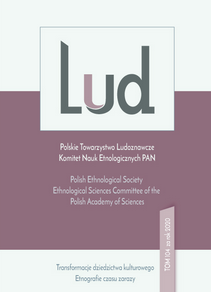ROLA LIDERÓW W KSZTAŁTOWANIU I PROMOWANIU DZIEDZICTWA KULTUROWEGO POZNAŃSKICH BAMBRÓW
THE ROLE OF LEADERS IN SHAPING AND PROMOTING THE CULTURAL HERITAGE OF THE POSNANIAN BAMBERS
Author(s): Agnieszka Szczepaniak-KrollSubject(s): Cultural history, Cultural Anthropology / Ethnology, Post-War period (1950 - 1989), Transformation Period (1990 - 2010)
Published by: Polskie Towarzystwo Ludoznawcze
Keywords: cultural heritage; Bambers; Poznan; leaders; stakeholders;
Summary/Abstract: The year 1989 was a breakthrough date in Poland’s recent history in various aspects. The change of the political system from socialist to capitalist, initiated in this period, freed many processes related to ethnicity. Also, the “renaissance” of Posnanian Bambers proved to be a direct result of the political transformation. Descendants of settlers who came to Poznań in 1719, during their more than 300 years of living in villages near Poznań, were often threatened with assimilation. So they developed their strategies of identity preservation, which they also used before 1989. Those strategies were individual, uncoordinated by anyone. In the 1990s, cultural leaders appeared for the first time in their history and took care of the heritage of the Bambers as a group. They began to search, popularize this cultural heritage and consolidate the group. The article mentions two people – Maria Paradowska and Ryszard Skibiński, who have special achievements in this field. Such people – social actors (today more often called stakeholders) have a significant impact on the shape of the cultural heritage of the group for which they operate and on the way it is promoted. I base the article on many years of participant observation and numerous conversations with Bamber leaders.
Journal: LUD
- Issue Year: 104/2020
- Issue No: 1
- Page Range: 101-136
- Page Count: 36
- Language: Polish

